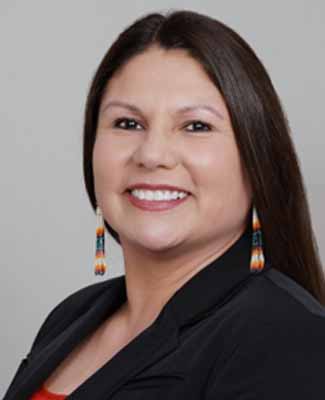Jonni Hertel
3rd Grade, General Beadle Elementary, Rapid City

Jonni Hertel, Wakȟáŋheža Thewíčhaȟíla Wiŋyaŋ, Woman Who Loves Children, has been teaching for 12 years. She currently teaches 3rd grade at General Beadle Elementary in Rapid City. Hertel, who is a member of the Cheyenne River Sioux Tribe, holds two master’s degrees in education. In this month’s Teacher Feature, she shares how she incorporates the Oceti Sakowin Essential Understandings and Standards into her classroom.
What made you decide to go into teaching?
I’m a dreamer, teaching wasn’t my first choice. My whole life I wanted to do different things. From plans on enlisting in the Marines, to being a smoke jumper, to pursuing a nursing career, to being a business owner, I wanted to do it all. I put myself out there and experienced different things, things that I’m grateful to have had the opportunity to do.
I had worked as a paraprofessional in two different districts and there is where I found my passion for the educational setting and the students they serve. I showed up for students the way I needed somebody to show up for me when I was younger. My passion then became my purpose.
What’s the best part of teaching?
Hands down, having an opportunity to be a part of a child’s life. Wakȟáŋheža is the Lakota word for children, it means sacred beings. How can you not think that being a part of a child’s life is not the best part of yours. You are entrusted with such a special gift. We are a small snapshot of their life, but in my experience, what I do in the classroom lasts long after they leave. I live on the Northside of Rapid where I’ve coached for many years as well as taught. I see my athletes and students all the time in our neighborhood. Many of my former athletes have now started families and their own careers. It’s always so good to see them and have an opportunity to reconnect and hear how they’re doing.
What’s the most challenging part of teaching?
I think the most challenging thing is getting teachers to understand the importance and the effect that the Oceti Sakowin Essential Understanding Standards has in the classroom. Since the Standards aren’t mandated by the state or districts, teachers have a choice on whether to teach them or not. Indigenous students have the lowest graduation rate in the state at about 48%, we can’t just continue to do the same thing and expect different results.
In my classroom, I incorporate language and culture as much as I can throughout the day. It matters and it allows a connection and understanding for all students. What I want everybody to know is that I am learning along with my students. I’m not a fluent speaker but I know the benefits of connecting to my culture and language myself and the benefits it has on my students, native and nonnative.
In the TeachSD video, you talk about wearing your ribbon skirts to school, and the impact it has on students.
Traditionally, ribbon skirts are worn during ceremonies and special events. In recent years, people have become more public wearing them. They can mean different things to different families and communities. They are considered a symbol of identity, resilience, and survival. To me, they are a part of my identity; they give me strength and empowerment. When making my skirts, I try to be in a good place mentally. I usually think about my uŋčis (grandmothers) and takóžas (grandchildren). They bring good thoughts and understanding as I’m sewing, and they become part of my skirts. At the end of the year, I gift my skirts to different people and start over again the next year.
I try to wear a ribbon skirt every day. I want students to see themselves and be proud to be Lakota or Dakota. Last year, each of my students had a ribbon skirt and wore them throughout the year. My hope is that they are empowered and embrace their identity.
If you could go back in time and give yourself advice at the start of your career, what would that advice be?
Back then public schools weren’t known to integrate language and culture in the classrooms, but I wanted to be a strong advocate for students. My advice would be, be brave and stay steady in your belief. When we’re doing things from our heart, we know it’s right for our students.
I took everything that I experienced in the classroom setting as a child and changed it.
Is there anything else you would like to add?
I love my job! We need more teachers, come teach with me!
I’ve been actively trying to recruit more Indigenous teachers into our district. That’s something that I would like to see for our students.
Why are Indigenous teachers important in South Dakota?
We have such a diverse population of students in public schools, but we lack diversity in the people that teach them. I believe this needs to be a priority. From breaking down stereotypes to building understanding, teachers of color have a strong impact on students as well as schools. Students need to be prepared to live in a multicultural world.
South Dakota is home to nine Oceti Sakowin tribes, and our schools serve students from many other tribes as well. Our students make up about 10% of the population throughout the state. Enlisting Indigenous teachers and teaching the Oceti Sakowin Essential Understanding Standards in schools brings knowledge and connection for all students.
My students don’t call me Ms. Hertel, I don’t like to be called such formal names. I am tȟuŋwiŋ (auntie). It’s a family concept, where we have a connection to each other. They understand my role, and they understand their own role within our classroom family. Mitákuye Oyás’iŋ (We Are All Related)
